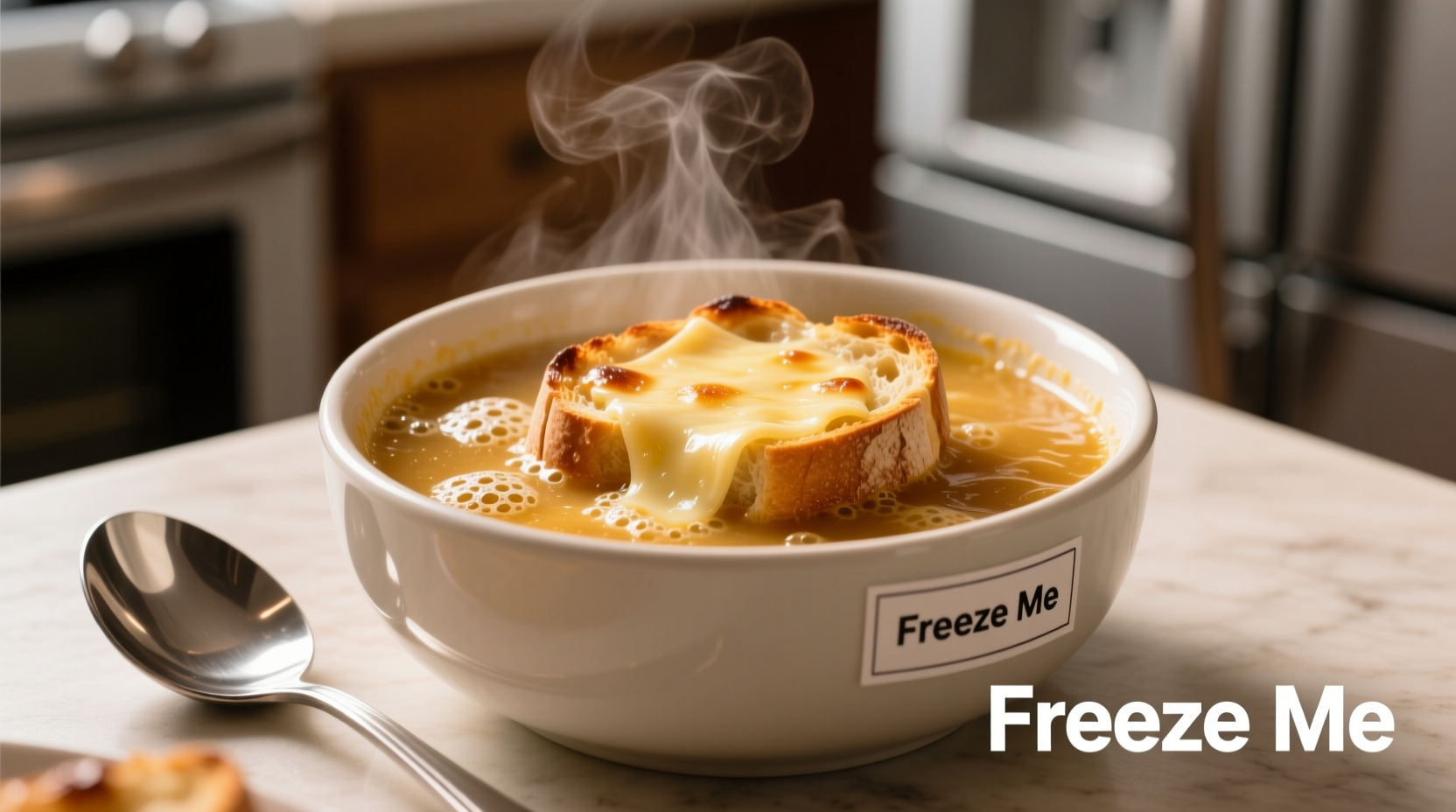Freezing onion soup properly transforms your culinary creation into a convenient future meal without sacrificing quality. As a professional chef with extensive experience in food preservation techniques, I've tested numerous methods to determine the optimal approach for maintaining that rich, caramelized onion flavor you worked so hard to achieve.
The Science Behind Freezing Onion Soup Successfully
Understanding the food science behind freezing helps you preserve your soup's quality. Onion soup contains high water content, which forms ice crystals during freezing. The key is minimizing large crystal formation that damages texture. Professional kitchens follow specific protocols based on USDA Food Safety Guidelines to maintain quality while preventing bacterial growth.
| Freezing Method | Texture Preservation | Flavor Retention | Recommended Duration |
|---|---|---|---|
| Properly cooled in airtight containers | Excellent | Excellent | 2-3 months |
| Plastic bags laid flat | Good | Good | 1-2 months |
| Leftovers in original pot | Poor | Fair | 2-3 weeks |
Step-by-Step Freezing Process for Perfect Results
Cooling Properly Before Freezing
Never place hot soup directly in the freezer—this raises the freezer temperature and creates condensation that leads to ice crystals. Instead, follow the FDA's two-stage cooling method:
- Cool from 140°F to 70°F within 2 hours (use an ice bath for faster cooling)
- Cool from 70°F to 40°F within an additional 4 hours
This two-stage approach prevents bacterial growth in the temperature danger zone (40°F-140°F) while preserving texture.
Selecting the Right Containers
Container choice significantly impacts frozen soup quality. Based on my restaurant experience, these options work best:
- Rigid plastic containers: Leave 1-inch headspace for expansion (ideal for portion control)
- Freezer bags: Lay flat for space efficiency and faster thawing
- Ice cube trays: Freeze portions for adding to future recipes
Avoid glass containers unless specifically designed for freezing, as thermal shock can cause breakage.

Freezer Storage Timeline and Quality Preservation
Understanding the freezer timeline helps maintain optimal quality. While frozen foods remain safe indefinitely at 0°F, quality degrades over time:
- Weeks 1-4: Peak flavor and texture retention
- Weeks 5-8: Slight texture changes become noticeable
- Weeks 9-12: Flavor begins diminishing; best used in mixed dishes
- Beyond 12 weeks: Increased risk of freezer burn and flavor loss
The National Center for Home Food Preservation confirms that properly packaged soups maintain best quality for 2-3 months in the freezer. Beyond this timeframe, while still safe, the soup may develop off-flavors and texture changes.
Thawing and Reheating for Restaurant-Quality Results
How you thaw and reheat determines your final product's quality. Follow these professional techniques:
Safe Thawing Methods
- Refrigerator method: Transfer container to refrigerator 24-48 hours before use (safest method)
- Cold water method: Submerge sealed bag in cold water, changing water every 30 minutes
- Direct reheating: Add frozen soup directly to saucepan over low heat
Never thaw soup at room temperature, which allows bacteria to multiply in the temperature danger zone.
Reheating for Maximum Flavor
Reheating properly restores your soup's original quality:
- Heat over medium-low until simmering (avoid boiling which breaks down texture)
- Add 1-2 tablespoons of broth or water if soup appears thickened
- Finish with fresh herbs or a splash of sherry for flavor enhancement
When Freezing Onion Soup Isn't Recommended
While freezing generally works well, certain situations make freezing less advisable:
- Soups containing dairy or cream (will separate upon thawing)
- Soups with delicate herbs added at the end (flavor diminishes)
- Soups that have already been frozen and thawed once
- Soups showing any signs of spoilage before freezing
The USDA Food Safety and Inspection Service emphasizes that freezing doesn't improve food quality—it only preserves the current state. If your soup wasn't perfect before freezing, it won't improve in the freezer.
Troubleshooting Common Freezing Issues
Preventing Freezer Burn
Freezer burn occurs when air contacts food surface. Prevent it by:
- Removing excess air from containers
- Using containers specifically designed for freezing
- Labeling with dates to ensure timely use
Restoring Texture After Freezing
If your thawed soup seems slightly separated:
- Whisk vigorously while reheating
- Add a small amount of cornstarch slurry if needed
- Blend briefly with immersion blender for smooth texture
Maximizing Flavor in Frozen Onion Soup
Professional chefs use these techniques to maintain flavor integrity:
- Underseason slightly before freezing (flavors concentrate during freezing)
- Add fresh herbs and finishing touches after reheating
- Include caramelized onions in the container for visual appeal
- Freeze croutons separately to maintain crunch
Remember that freezing preserves but doesn't enhance flavor. Your soup's quality after thawing directly reflects its quality before freezing.











 浙公网安备
33010002000092号
浙公网安备
33010002000092号 浙B2-20120091-4
浙B2-20120091-4